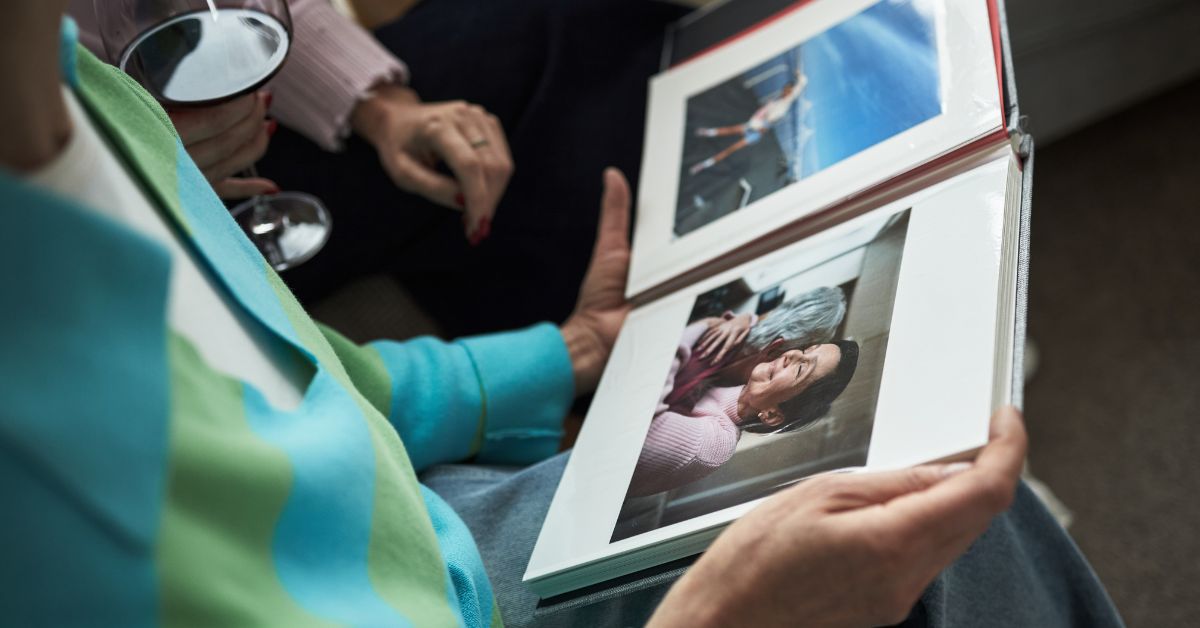
Family stories hold remarkable power for seniors in memory care in Menomonee Falls. These narratives create meaningful bridges between who someone was and who they remain today.
Storytelling has always been how we make sense of our lives and this becomes even more precious when memory faces challenges. When residents share stories about their experiences, something beautiful happens—conversations flow more naturally and genuine connections form with others around them.
Building Emotional Connections Through Storytelling
Something profound occurs when we truly listen to another person’s story. Sharing personal narratives can strengthen the bonds within families and social groups. When caregivers and family members give their full attention to residents’ stories, they send a clear message: your experiences matter and you matter. This simple act of listening validates residents in ways that go far deeper than words can express.
Memory may shift and change, but the essence of who someone is remains intact. Family stories serve as gentle reminders of that unchanging core identity. Think of these narratives as a personal guidebook—one that contains the most important details about someone’s background, passions and values.
These stories work like anchors, keeping residents connected to the memories and experiences that shaped them. Even when dementia progresses, people can still create meaningful stories about their lives and relationships. Through family narratives, residents can still express their authentic selves, share how they became who they are and communicate what continues to matter most to them.
Creative Activities That Bring Stories to Life
Creative expression opens doorways to memories that might otherwise remain locked away. When residents in memory care engage with art, music and sensory experiences, something beautiful happens—their stories find new ways to emerge, even when words become elusive.
Art projects for dementia patients
Art becomes a language when spoken words feel distant. Watch someone with dementia pick up a paintbrush and you’ll see their face light up as colors flow across the canvas. There’s no wrong way to create—that’s the beauty of it. Bold strokes of red might represent a favorite rose garden, while gentle blue washes could echo memories of peaceful lake mornings.
Simple projects work wonders.
- Picture frames adorned with smooth shells might spark stories about beach vacations from decades past.
- Paper flowers crafted with gentle hands often trigger conversations about wedding bouquets or garden parties.
Art has helped many people with dementia live meaningful lives, staying happy and engaged despite their condition. These creative moments offer something precious—a sense of accomplishment that doesn’t depend on perfect recall.
Hands-on activities that spark memories
Your hands remember things your mind might struggle to grasp. The soft texture of yarn between fingers can transport someone back to knitting baby blankets. Smooth wooden beads might awaken memories of childhood crafts with your grandmother. These tactile experiences reach deeper than words alone ever could.
Consider these memory-rich activities:
- Flower arranging, where colors and fragrances tell their own stories
- Creating collages from magazine pictures that capture personal interests
- Making sachets filled with lavender or rosemary, scents that often unlock childhood memories
When multiple senses work together, they create stronger pathways to treasured moments from the past.
Music and photos to trigger storytelling
Music lives in a special place in our minds that dementia rarely completely touches. Play that special song that was danced at their wedding and watch their eyes brighten with recognition. Those familiar melodies can unlock detailed stories that seemed lost forever.
Family photographs work similar magic. Even when faces become harder to name, the emotions tied to those images remain powerful. Looking through photo albums together creates natural opportunities for storytelling. Details might blur, but the love behind those captured moments shines through clearly.
Group storytelling circles and memory games
Shared storytelling creates something special—a space where everyone belongs, regardless of how clearly they remember. Remember that imagination matters more than accuracy. When the pressure to remember “correctly” disappears, creativity flourishes.
Simple memory games like matching cards or completing familiar sayings provide gentle mental exercise while preserving each person’s dignity. Everyone can participate at their own level, finding joy in connection rather than struggling with perfect recall.
Why Family Stories Matter in Memory Care
Family stories hold the power to connect hearts across memory challenges. Each narrative carries the essence of who residents are—their joys, their wisdom, their place in the world. When we honor these stories, we honor the person behind the diagnosis.
Your family’s history is worth celebrating and preserving. The journey through memory care becomes more meaningful when personal history remains alive and accessible. Call Heritage Court Menomonee Falls at (262) 781-6930 and schedule a tour to learn more about our specialized programs for seniors.
FAQs
Q1. How do family stories benefit residents in memory care?
Family stories help residents maintain their sense of identity, build emotional connections with caregivers and family members and create a feeling of belonging. These narratives serve as powerful anchors to their past and present, even when facing memory challenges.
Q2. What are some effective ways to capture and share family stories in memory care?
Effective methods include organizing senior storytelling sessions, recording interviews with residents, creating memory journals and scrapbooks and engaging in hands-on activities to create keepsakes. These approaches help preserve important memories while providing opportunities for engagement and connection.
Q3. How can creative activities enhance storytelling in memory care?
Creative activities like art projects, sensory-rich experiences and music can trigger memories and facilitate storytelling. These activities provide alternative means of self-expression when verbal communication becomes challenging, allowing residents to connect with their personal histories in meaningful ways.


